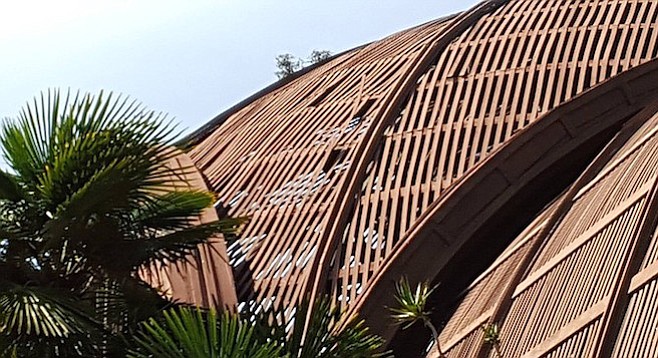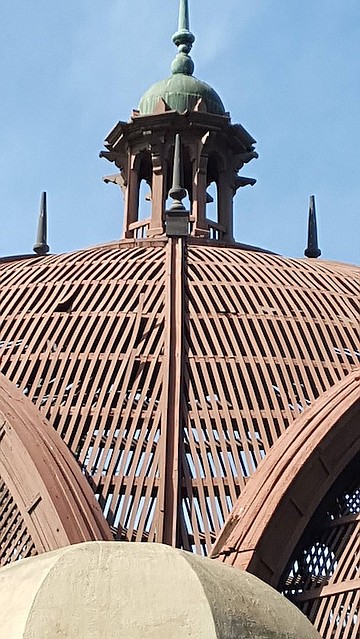 Facebook
Facebook
 X
X
 Instagram
Instagram
 TikTok
TikTok
 Youtube
Youtube

The Botanical Building in Balboa Park is one the largest lathe structures in the world, according to David Lundin, cofounder of the Balboa Park Heritage Association. The association was formed in 2014 to help create events for the centennial of the 1915 Panama-California Exposition. As the highly touted year-long celebration flopped, their focus changed to the preservation of Balboa Park.

Lundin said on April 27, “The Botanical Building was designed to require a major renovation of the redwood lathing every 15 years. This needed work was last done 40 years ago.”
Even though the Balboa Park Conservancy Group selected the Botanical Building in 2013 as their first major restoration project in years, the group has yet to find donors to open their wallets to the tune of more than $3 million. According to Lundin, the last major restoration in Balboa Park was in 1997, when the House of Hospitality was reconstructed.
Per Lundin, the conservancy group is now proposing to spend even more on an expanded renovation of the Botanical Building, requiring the sacrifice of a significant portion of interior space for a gift shop, employees’ bathroom, and chairs and service bars for events.
“The interior would be more open ballroom space than botanical garden,” said Lundin.
The mayor’s promise in January 2016 to break ground on 50 parks in five years leads Lundin to ask, “Why don’t we take better care of the parks we already have rather than building new parks that also must be maintained? Many neighborhoods in the city are unfairly ‘under-parked,’ and changing that should be a priority; however, restoring our crown jewel must also be a priority.”

As far as other structures in Balboa Park that need immediate attention, Lundin said, “It’s a long list. Casa del Prado and courtyard are a disaster. This was last renovated in 1971. Casa de Balboa has major fresh and wastewater failures, a failed roof, and mold, mildew, and dry-rot everywhere. Only this morning [April 27], the major valves for the fire-suppression system for this building failed.”
In November 2015, the conservancy group released a request for proposal for the Botanical Building’s restoration and enhancement. On April 28, Tomás Hererra-Mishler, director of the conservancy group, said that five proposals were submitted in January 2016. Ultimately, RNT Architecture was awarded the project. Hererra-Mishler said, “Their senior designer is well known in the park, as he designed the new Friendship Garden.”
Partnering with RNT will be Spurlock Landscape Architecture and Tres Fromme. “Tres Fromme is a rock star in the world of horticulture,” said Hererra-Mishler. “He’s coming on June 8 at 6:00 p.m. to give a lecture at the Museum of Photographic Arts about public horticulture. He is a super-engaging speaker that knows how to light a spark in people’s imagination.” (To attend, RSVP with Gina at [email protected].)
The project will have five phases, with the first planning phase scheduled to be completed by December 1, 2016.
“What’s really exciting is that by mid-summer, the vision should be defined,” he said. “We’ll have wonderful graphics to tell the story with a clear-cut cost estimate so we’ll know how much we need to raise.”
When asked if $3 million is near the total expected budget, Hererra-Mishler said, “Absolutely not. The project has expanded, including the surrounding landscape and reconstructing all original features lost from 1915.”
“What we’ve done is raise $500K for the first planning phase to help quantify the project and allow us to have the conversation that we need to have with stakeholders.”
As far as the other phases, when they start depends on funding availability. The bulk of the funding will still need to come from big donors, with some money raised from special events.
“The other component to the fundraising strategy is that after the renovation, it will cost more to maintain the building than the city has allocated, so we will need endowment funds to make sure it’s kept up to a fantastic level,” said Hererra-Mishler.
New lighting is within the scope of work.
“The lighting we are envisioning for the outside is to highlight the special architecture,” said Hererra-Mishler. “For the inside, we want to add lighting to do a couple of things: highlight plant materials and create more usable hours. We close at 4:00 p.m. now and would like to keep it open later to host after-hour special events.”


The Botanical Building in Balboa Park is one the largest lathe structures in the world, according to David Lundin, cofounder of the Balboa Park Heritage Association. The association was formed in 2014 to help create events for the centennial of the 1915 Panama-California Exposition. As the highly touted year-long celebration flopped, their focus changed to the preservation of Balboa Park.

Lundin said on April 27, “The Botanical Building was designed to require a major renovation of the redwood lathing every 15 years. This needed work was last done 40 years ago.”
Even though the Balboa Park Conservancy Group selected the Botanical Building in 2013 as their first major restoration project in years, the group has yet to find donors to open their wallets to the tune of more than $3 million. According to Lundin, the last major restoration in Balboa Park was in 1997, when the House of Hospitality was reconstructed.
Per Lundin, the conservancy group is now proposing to spend even more on an expanded renovation of the Botanical Building, requiring the sacrifice of a significant portion of interior space for a gift shop, employees’ bathroom, and chairs and service bars for events.
“The interior would be more open ballroom space than botanical garden,” said Lundin.
The mayor’s promise in January 2016 to break ground on 50 parks in five years leads Lundin to ask, “Why don’t we take better care of the parks we already have rather than building new parks that also must be maintained? Many neighborhoods in the city are unfairly ‘under-parked,’ and changing that should be a priority; however, restoring our crown jewel must also be a priority.”

As far as other structures in Balboa Park that need immediate attention, Lundin said, “It’s a long list. Casa del Prado and courtyard are a disaster. This was last renovated in 1971. Casa de Balboa has major fresh and wastewater failures, a failed roof, and mold, mildew, and dry-rot everywhere. Only this morning [April 27], the major valves for the fire-suppression system for this building failed.”
In November 2015, the conservancy group released a request for proposal for the Botanical Building’s restoration and enhancement. On April 28, Tomás Hererra-Mishler, director of the conservancy group, said that five proposals were submitted in January 2016. Ultimately, RNT Architecture was awarded the project. Hererra-Mishler said, “Their senior designer is well known in the park, as he designed the new Friendship Garden.”
Partnering with RNT will be Spurlock Landscape Architecture and Tres Fromme. “Tres Fromme is a rock star in the world of horticulture,” said Hererra-Mishler. “He’s coming on June 8 at 6:00 p.m. to give a lecture at the Museum of Photographic Arts about public horticulture. He is a super-engaging speaker that knows how to light a spark in people’s imagination.” (To attend, RSVP with Gina at [email protected].)
The project will have five phases, with the first planning phase scheduled to be completed by December 1, 2016.
“What’s really exciting is that by mid-summer, the vision should be defined,” he said. “We’ll have wonderful graphics to tell the story with a clear-cut cost estimate so we’ll know how much we need to raise.”
When asked if $3 million is near the total expected budget, Hererra-Mishler said, “Absolutely not. The project has expanded, including the surrounding landscape and reconstructing all original features lost from 1915.”
“What we’ve done is raise $500K for the first planning phase to help quantify the project and allow us to have the conversation that we need to have with stakeholders.”
As far as the other phases, when they start depends on funding availability. The bulk of the funding will still need to come from big donors, with some money raised from special events.
“The other component to the fundraising strategy is that after the renovation, it will cost more to maintain the building than the city has allocated, so we will need endowment funds to make sure it’s kept up to a fantastic level,” said Hererra-Mishler.
New lighting is within the scope of work.
“The lighting we are envisioning for the outside is to highlight the special architecture,” said Hererra-Mishler. “For the inside, we want to add lighting to do a couple of things: highlight plant materials and create more usable hours. We close at 4:00 p.m. now and would like to keep it open later to host after-hour special events.”
Comments